2018 Mustangs training and preparation for the long ride CDT
- Peter van der Gugten
- Mar 13, 2018
- 19 min read
Kathy and I are moving to Colorado USA. So officially only Kathy, she will live with our daughter in Larkspur Colorado until we have found something of our own. I will stay in Switzerland and have obtained a visa to stay in the USA for 6 months per year. We say goodbye to our horses, Flash goes to a retirement pasture, Cool goes to a trail riding station in the north of Germany, only Artvin stays at the stable. Hermes goes to Germany, where he will learn to tölt.
On Nov. 2, we fly to Colorado. We live in a caravan with what feels like 12 square meters of living space. When we arrive, the shell of the guest house is already finished and the interior work will be completed in the first few weeks. The weather is fantastic, dry, sunny and only occasionally cold with a little snow. Except when it's windy, which sometimes happens, it's very pleasant.
I'm dealing with the authorities to get two more mustangs, but the cultural differences are exhausting. They keep telling me how pretty the horse is, what color it is, that it has a great mane or a star, but the size, age or even character of the horse is hard to find out. I get the impression that the horses here have to be as good as lambs before they can be put up for adoption. Their biggest concern is that I wouldn't be able to afford to keep the horses. In the end, I have four different organizations that want to make mustangs available to me. Finally BLM (Canon City) gets in touch and I can now pick up horses earlier than January. Out of about 30 animals, 20 are mares, the rest are either only 1-4 years old or only 140 cm plus tall. Now that I have finally picked out two horses, I have to fill out x number of forms to get a single appointment to pick up two horses. I can't look at them beforehand. I can see the boys on the internet in 2x3 cm photos. That must be enough.
Today I got a call from one of the Equine Centers that take mustangs from the Bureau of Land Management BLM. They had a mustang that I could pick up. I'm going to look at him. His name is Rodeo. A few days later, however, I can go and see more geldings 2 hours to the north. When I get there, it's pretty chaotic. 97 horses have been taken in there in a year, about 15 are still there. However, they are only given away in pairs. And unfortunately, the pairing cannot be defined, as half of the horses no longer have an identification tag.
After a month, the Man Cave is finished, stables built and 1 ha of land fenced in. Ahi the Criollo from Argentina is being delivered to me privately and today I picked up Rodeo, a Kentucky Mountain Horse (caught in the wild). Tuesday I'm going to Canon City to the BLM to pick up one of two selected horses.
Since Wednesday, the 3rd in the group is now at the ranch. Deets, he is a BLM mustang from California, who was kept in the Canon City prison here in Colorado and tamed by inmates of the prison. On Thursday, Melly arrived to take over the training of the three horses. The three horses have different characters. Deets is friendly, easily distracted but willing to learn, has already been ridden but is still a little timid. Rodeo is rather suspicious, dominant, but attentive and eager to work, has already been ridden, but is not enthusiastic about it and wants to leave under saddle. He comes from the Equine Sanctuary, a horse rescue center near Castle Rock. He was captured from the wild in Kentucky and broken in at the sanctuary for the 2nd time. He must have been under saddle before he was captured. Ahi is intelligent, but shy of work and people. Ahi lived the first 6 years of his life in a pasture south of Buenos Aires at Estancia El Cardal, then was in training for 14 days before I brought him to Atlanta in January, where he stood in a pasture until he arrived in Colorado. The three horses are in a pasture with direct access to the paddock and stable. They are still confined to the paddock at night, but in a day or two they will have free access to the pasture 24 hours a day.
Here we try to explain the training process for the three horses.
Day 1. Approach
As the horses run away when we try to fetch them, on the first day we try to convey to the horses that they are calm and secure in our presence and that it is not about work.
We go out into the pasture and approach one of the horses in a roundabout way. As soon as the horse realizes that we are after him, we stop and wait, if he comes towards us we back off, if he moves in the other direction we put a bit of pressure on him and stop again. It's like a kind of dance in which the horse leads and we react, but make him uncomfortable when he moves away and comfortable when he turns towards us. Deets is the easiest, after 1-2 repetitions, he comes towards us and lets us tie him up. Rodeo is also willing, takes a little longer, but it actually goes surprisingly well. Compared to January, Ahi is already really eager to get down to business, but is still the one who least likes to be fetched. We praise and stroke the horses, touch them all over, lift their feet, scratch their ears and try to find out what they like and don't like. We move very slowly and calmly and speak very quietly and sonorously.
2. a friendly game
Same ritual as yesterday, but today we want their attention, we want them to turn to us and become interested in working with us. Again, we seek contact, scratch and praise them, and lead them in tight voltes in the arena. We want them to stop on voice command and follow us, whereby they initially react mainly to our body language. We make ourselves big to stop them, make ourselves small to move them.
Day 3 Jojo Game
We want to consolidate what we have learned and work on some weaknesses. Ahi reacts very strongly to the swinging rope, so we will get him used to it a little more so that he is not afraid of the rope. Rodeo always struggles to stand still at first and we want him to stand still with the rope on the ground so that we can walk around him without him following us. Deets is easiest on the rope, he gives way and comes on command, Rodeo has also realized that he has to give way backwards to the pressure of the swinging rope. We try to strengthen the connection between the verbal command and the swinging rope and place more and more emphasis on the vocal command. We start with forehand and hindhand turns and stop at a positive point. In the afternoon, we put on the measuring fences and adjust them to the horses' backs.
Day 4 Porcupine
The horses give way from the pressure on the neck and thigh, in both directions. We want slow step-by-step forehand and hindquarters turns and we want to keep them moving, but we don't want to hurry them either. We bought saddles today. The measuring grids were marveled at by the salesmen.
Day 5 Saddle The horses are taken from the pasture and held by a loose rope. Melly brings the saddle and lets Rodeo sniff the saddle. Then she walks away from Rodeo with the saddle on her arm and lets him follow on the loose rope. She stops and lets him sniff, then walks away backwards again. When Rodeo stands still, she approaches from the side and carefully puts the saddle on. She makes sure that the stirrups and girths slide down slowly and don't frighten the horse. Then we lead the horse with the saddle in tight voltes, turn the horses backwards, bigger turns, and then the various games again with the saddle on. Deets reacts violently to the girth, Ahi follows the saddle, but when we try to put the saddle on, he constantly moves out of the way. Today the horses are staying out in the pasture for the night. When we went to fetch them, all three were lying down and dozing with their necks erect.
Day 6 Saddle and break
In the morning, the horses are fetched from the pasture without ropes and saddled up individually. Rodeo had no problem, Deets was very tense and was girted gently. Ahi played the same game as yesterday, so Melly led him into the stable, where he could only give way to a limited extent, and was saddled there. The horses move freely around the paddock with the saddle on. Melly wants the horses to be able to give way when saddled if they are not feeling well. The horses have a break today until the evening.
8 day saddle familiarization phase and saddle check
The horses are saddled individually without a pad and the saddle is moved on the horse. Stirrups knock against the belly, girths fall on the flanks.... All this is repeated until the horse has become accustomed to it. The horses are led into tight turns with the saddle to see how the saddle releases the shoulder or not. The saddles are inspected. Girth straps need to be replaced and one of the saddles needs D-rings for the front harness. The rear bars for the pulley need to be purchased and D-rings for the front pockets fitted. The nailed leather parts are re-screwed and all fastenings on the saddle are checked.
Day 9
Ahi moves backwards as soon as you approach him with the saddle. When Melly walks away from him with the saddle, he follows her, but as soon as she walks towards him again, he moves backwards again. In order to still be able to work on him with the saddle, we put him in the stable, where he had less room to move but was still free. Later we did this in the paddock, but we held the rope with the left and thus his position while the saddle was on the right. Saddle up and down again until he was standing reasonably still. Rodeo is still struggling to stand freely on his own. I therefore put the rope on the ground in front of him and demand with a verbal command, Woah, that he remains standing. I move slowly around him without allowing him to move. If he moves, whether only one step or more, I break off, return to his head, bring him back into position with Back and demand that he stands still. When he has stood still for some time (1 minute), I start walking around him again. Every movement of his head or foot is acknowledged with a woah. After a few interruptions, it works and he chews. I praise him and scratch him extensively. Subsequently, when we approach Rodeo with the saddle, he moves a step away, but can be corrected with a rope or verbal command and remains calm when saddled. Deets is the calmest here. He is also skeptical, but hardly moves when he is saddled up. However, he has a girth compulsion when being saddled, so we girth him slowly and carefully to take this compulsion away.
Day 10
It may be December here in Colorado, but the temperatures are still very pleasant. 15 degrees at midday when the sun is shining, but cool in the morning and as soon as the sun is gone.
Today we put blankets on the horses before we saddle them and check the fit of the saddle with the blanket. Melly climbs into the stirrup and lies over the saddle, touches the croup and belly on the other side with her hand and gets off again. She repeats this from both sides. Rodeo has the most problems with the weaker right side, she dismounts, leads him, makes tight voltes and tries again and again.
After several attempts, it works. Deets and Ahi take it in their stride. We praise extensively and repeat without sitting in the saddle.
Day 11
Deets' hindquarters When we check his hooves (which had been trimmed by the local farrier before we picked him up), we notice that Deets has a problem with his left hind leg. He loses his balance as soon as you try to lift this leg. That's why he constantly tries to escape the situation. So I hold him by the loose rope and touch his hip downwards, inside his thigh, until I can grasp the cannon bone. I hold it firmly and try to lift the leg, but he keeps pulling it away. After about 10 attempts, he allows me to touch his thigh and hold his leg, but I can't lift it without him moving away. Melly takes over and puts the rope over Deets' neck so that he can't turn away easily. She starts stroking his croup and moving further down, but he knows what's coming and is already starting to give way. Melly can control the movement with her hand on the dorsal vertebra and after a while he accepts that she can touch his hindquarters. We realize that he is not balanced and correct his hoof position before we ask him to give us the hoof. Melly can now lift the hoof about 10 cm towards his belly and strokes his whole leg to calm him down. She slowly lifts the leg higher and later also backwards, tucking her knee under the hoof. On the Down command, she guides the hoof to the ground and he then pulls the leg up again before putting weight on it again.
Day 12
Ahi and Rodeo both have cracks in their hooves caused by flares. If the hooves are not cared for properly for a long time, the horn wall separates from the sole and is pushed more and more towards the horizontal by the load. At some point, a crack appears at the edge of the hoof because the load is applied in different directions at different points. The hooves were shortened, the flares removed and the two sides of the crack shortened to such an extent that they can no longer absorb any pressure.
When we fetch Deets from the pasture, he is the only one who stands still and can be led on the lead rope or knotted halter, but after a few meters he simply stops, lifts his head and puts his legs on the ground. Melly leads him into the paddock and asks him to walk behind her and when he stops, she drives him around her with the rope on his hindquarters. After a few turns around Melly, she starts trotting alongside him. We notice that as soon as there is a pull on the rope, he starts to resist. She repeats the game until he willingly trots alongside her, and as soon as he does this for a few steps, she stops and praises him. After about 10 minutes, she has got him to the point where he follows her even though there is a little tension on the lead rope and allows himself to be led without asking. Deets also always has problems when I lead him on a halter. This may have something to do with the fact that I am then too close to him and he doesn't like it. Nevertheless, it has to be possible, so we practise it again and again until he accepts it. Rodeo makes a game out of being fetched from the pasture. When he sees you coming with the rope in your hand (work), he moves out of the way and then stops. After one or two times, he then stands patiently until you have tied him up. He follows without any problems with or without a lead. Ahi is the one who is generally difficult to catch. When everyone else is in the paddock, he comes and wants to join his colleagues. But otherwise it's like a dance. You approach him, he moves away, we drive, he stops, we stop and ask him to come. We approach him like this until he stops and you can grab his halter.
Day 13
Today the vet came and examined the horses. Everything sounds and feels good and he checks the documents that were given to me when I bought the horses.
A cogin test will be done for all three horses. Ahi will be fully vaccinated, 6 different vaccines in three doses, (just for convenience) and Rodeo will get a missing rabies vaccine. Teeth need to be done on all three, but it's nothing urgent. The only concerns the vet communicates are the two cracks in the hooves, but I'm not too worried about them. We get Equipalazone in a tube (1 gram twice a day) if necessary, and a colic medication orally. He has a mobile X-ray machine, can carry out colic operations himself in his practice and is in the process of setting up a Resque Center (a sanctuary for horses).
He has been involved with horses locally for 25 years and seems very competent. We do very little work with the horses today, we lunge them in the arena, which involves them keeping to a set pace, speeding up or slowing down on voice command. stopping and walking backwards. If they turn towards us, they are immediately sent in the other direction and have to go another round before they stop and walk backwards. If they have done this successfully, they are allowed to come to us in the middle on command and are praised.
Day 14
Squeeze game We set up two pallets across the corner of the paddock and I lead Deets towards the corner. He stops in front of the corner of the pallets and refuses to go any further. I demand that he stops, walk sideways behind him and carefully drive him towards the corner with the rope. He slowly moves towards the passageway and steps into the corner. I release the pressure and praise him. Now I go to him in the corner and lead him out again on the long rope on the other side. This time he follows without hesitation. Carefully, but without stressing. The three of them seem to be very resistant to stress. Melly does the same with Rodeo, who doesn't follow her either, but can be sent into the corner without any problems. Rodeo can also be turned around on the 1.5 x 1.5 m corner and sent back in the other direction and this morning we saw him standing in the corner voluntarily. Ahi also has no problems, can be led into the corner, but also goes in voluntarily on command, although he is reluctant to stay there and keeps pushing towards the exit. We find a fly curtain and use it to desensitize the horses with the fluttering plastic strips. While Ahi and Rodeo are relatively relaxed about the whole thing, Deets eyes it suspiciously, but after a few attempts he has no problem with the ribbons being pulled over his ears. We hang the fluttering ribbons at the stable entrance. In the meantime, my granddaughter has arrived and wants to help. She is allowed to lead Ahi, who has the least problems with children of the three. Rodeo doesn't do anything, but puts his ears back when the children are around, Deets doesn't want to be touched by the children on his face, but he puts up with it on his flank and neck. While the little one leads Ahi, I hang on to his tail and let him pull me around the arena. Finally, I swing the lead rope over Ahi's back and tie his feet loosely together. I am surprised that there is no reaction at all and am pleased that hobbling will be so unproblematic. I repeat the same with Deets and Rodeo and they also have no problem with a rope tied around their front or hind legs.
First ride
Friends drove 6 hours to spend two days with us. The weather is great, cold, snow, but lots of sun. We take the horses for a walk. The children are with us and we ask permission to go to the farm of some friends. The horses are confronted with cows, other horses, donkeys, hard, stony paths and passing cars. No problem. We let the two children lead the horses when we enter the forest and I enjoy just watching them.
3.1.2018
After our luggage has finally arrived, we can also saddle Ahi. However, we change saddles again from Ahi to Rodeo and vice versa, as Rodeo's saddle is too small for me. Melli and Karin ride with the other two horses and we leave the pasture across the meadow to the road. Rodeo goes ahead and makes good speed, but he is very nervous and keeps asking what he should do. Later, as we enter the forest, he calms down and when he can walk behind Deets, he really relaxes. Karin rides in front with Deets, and although all the horses are very peepy, every post box and transformer station is eyed critically, it is no problem to ride the three horses.
Ahi is the slowest of the three, he also has the shortest legs and Rodeo must have some extra gear, because as soon as you push him to go faster, his pace shifts and he becomes very comfortable but fast.
18.2.
We have two mustangs and a criollo. All three were only broken in and had to learn the basics for trail riding first. E.g. planing, high wire (highline), electric fence, leading, rope course etc. In the last two months, the horses have been trained on the mountain at a walk and the riding time has been extended from 2 to 8 hours a day. Next week we will start interval training. This means we will ride 10 minutes walk, one minute trot. The trot phases will always be extended by one minute and the walk phases shortened accordingly by one minute until we can trot for an hour. We'll see if we can do more. As we plan to walk 40 km a day, the horses have to be fit for 60 km a day. At the same time, the horses have to be familiarized with all the elements of civilization, as they have never been exposed to them in the wild. What is already certain is that we reach an average walking speed of 6 km/h and can accelerate to 7 plus at a walk. However, our littlest one finds this difficult. We can jog with all three of them as soon as we demand more than 7 km/h. The Criollo already jogs from 6 km/h. All three are comfortable to ride, but need to become braver and more confident. Although the three are a herd, they must not stick together and must be able to go their separate ways without any problems. On the other hand, one of the horses will always run free.
Deets comes from the RedRock Lake area in California. The ancestors of the wild horses possibly go back to the Spanish mustang. The Spanish bloodlines were diluted by a wide variety of horses brought to the area by pioneering ranchers. These horses tend to be stocky and tall, reaching up to 16 hands in height. There are quite a few Appaloosas in the herd as well as the more common solid-colored animals.
Location: The Red Rock Herd Management Area is located 10 miles east of Macdoel, California, in northern Siskyou County, California.
Size: 18,541 acres 9000 ha
Topography/Vegetation: Red Rock Lakes sits at an elevation of 4,600 feet and is the focal point of the wild horse area. The top of the ridge, Mahogany Mountain, is 6,250 feet high. Vegetation consists of big sage and low sage, with an understory of Idaho fescue, squirreltail and needlegrass. In many areas, juniper has greatly increased in density and understory shrubs and grass species are absent.
Wildlife: Wildlife along the ridge includes mule deer, antelope, coyotes, bobcats, hawks, eagles, sage grouse, pheasants, mountain quail and mourning doves. Many waterfowl nest and rest in the lakes when there is enough rain for years.
Deets is like a little puppy. He is interested in everything, looks at everything. If he's scared of something and you can tell him to walk past it, he will, but he doesn't do it as boldly as Rodeo. He's more reactive. (Partly I think you can see the age difference between the two of them). But if you ride him and give him security, he'll do well as a lead horse.

Rodeo has developed into a great lead horse. I think he's the bravest of them all. When he sees something scary, he freezes for a second, then I ask him to move on and he keeps going like he didn't see anything. Sometimes he still likes to look at my feet, but he does it out of insecurity, so I just tell him he's fine and then it's fine. Anyway, it's better to voice train him. I think he's our best lead horse, but we have to work hard until he trusts us. He also just blocks if you put too much pressure on him. Rodeo, when he understands the job, he just gets it done without getting distracted.

Ahi is also great, he does everything I ask of him and he tries to go quickly when I put pressure on him. All in all, he's a very obedient horse and tries to please me as much as he can. But sometimes he puts people to the test. Lukas' sister rode him. He found out that she couldn't control him. But when we got home and I rode him again, he was as good as ever, he can be cheeky.
Ahi Vehemos Resero, "Spanish, here you see the drover", is one of the famous criollos of Estancia El Cardal in Ayacucho, south of Buenos Aires in Argentina. He was given to Ross Birrell by the owner of the ranch for his art exhibition "Criollo". Ahi was transported to Buenos Aires and is the only horse of modern times that was allowed to walk around the Plaza San Martin in the city of Buenos Aires. He was later flown to Miami as part of the Art Expo and transported by trailer to New York. Where the movie Criollo was shot. (Ross Birrell Documenta 14). From there he traveled via Georgia to Colorado, where he is now staying. He will continue his journey as he is part of the Long Trekk team. Mexico to Canada.

When I came back from New Zealand, I found three calm and willing horses that were in great shape. Melly had done a great job of gaining their confidence and getting them used to working with planes, ropes and ferries. As we progressed with planning the 5000km journey, we realized that given the situation, it would be beneficial to have a fourth horse. When I spoke to my daughter about it, she decided that she would like to get a horse and we would train it and use it for the trip.
March 2018 We got Kapuni Kiowa, our 4th mustang, from a nearby shelter and he was the calmest horse you could imagine. Halter trained after two weeks. We saddled him on the second day he was with us and on the third Melly and later Karin were allowed to ride him in the corral. No bitching on his part...
That's why we now have Kiowa Kapuni with us. He comes from the White Sand Basin and had a broken halter when we bought him from a nearby shelter. We started working with him immediately and found him extremely willing and cooperative. Over the next few days we will continue with ground work and get him used to the different trail situations like the others.
11.4.
Return to Switzerland at the end of March. Hermes is sold to a lady in Germany. Tax declarations have to be done, visas organized and of course I have to take off with Artvin, my Kabardiner. Easter was a great time to ride him with some old friends in southern Germany (Hegau).
18.4.
Mid-April trip to Glasgow with Tina and Melly. On the way, we'll be taking carpenters in traditional dress with us to ferry them to England. My trailer will be part of the exhibition and the Athens-Kassel team will once again celebrate our trip together with an exhibition at the Contemporary Art Gallery in Glasgow.
We will be joined by Theresa and Oskar Solanet, the ranchers who sponsored "Ahi to the Movie" by Ross Birrell. Benno Affolter will be there (biography of Aime Tschiffely).
19.4.
Ausstellung
20.4.
Don Roberto (Cunnhingham Graham), as he was known in Argentina, was a friend of Tschiffely's who ensured that the book could be published at all. Together with Benno Affolter (Aime Tschiffely's biographer), we visited Don Roberto's grave on the island of Inchmehome, which belonged to the estate of the landowner and founder of the Scottish Socialist Party.
30.4.
End of April. Together with Szolt, we fly back to Colorado. The horses are stronger, but have to trust us again. The first few times it was difficult to catch them in the big field, so we decided to put ropes on their halters and even hobbled them. They seem to know what to do with the hobbles, they galloped off with the two-legged hobbles with no problem. So we took them off again. The rope seems to work perfectly.
3.5 Brand Inspector
Horses in the USA do not have a horse passport as we know it in Europe. But a brand inspector can issue a document that allows them to travel throughout the USA. In addition to this yellow A6 document, we require a health certificate from your local veterinarian and a Cogins test, which must not be older than 12 months. The task of the fire inspector is to officially confirm the ownership of animals. As horses, like mustangs, used to be branded, the brand was the proof. So today we got 4 passports and tomorrow we will shoe the horses....
5.5. farrier
Today the weather is miserable, it's snowing and raining and windy. John the farrier is here to nail on Duplos. The horses were shod for the first time, except Ahi, but they all behaved well.













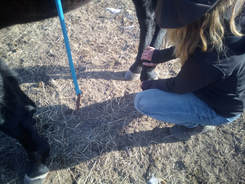




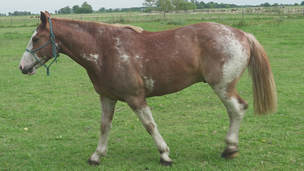


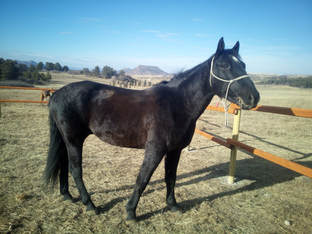




















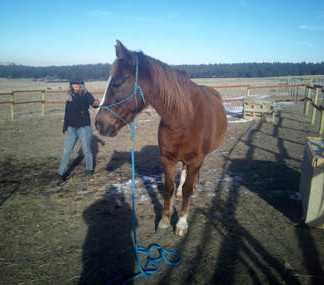








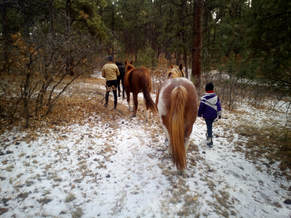





















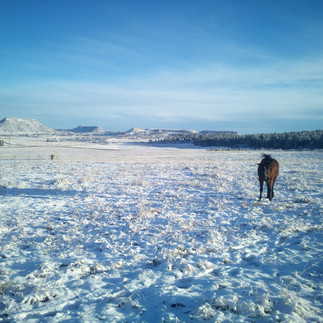




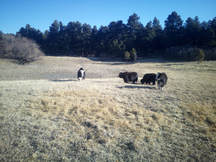



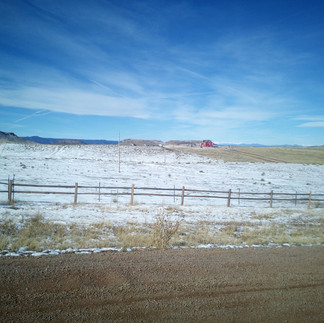


























































Comments